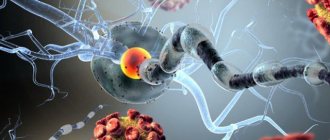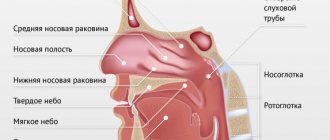Multiple sclerosis is a fairly common diagnosis nowadays and, importantly, it is given to young and middle-aged people (15–40 years old). MS is a disorder of the nervous system caused by:
- genetic predisposition (gene mutation);
- infections and viruses of various kinds;
- lack of vitamins, especially group D;
- injuries;
- malfunctions of the immune system;
- severe stressful situations, etc.
Also at risk are diabetics and people with thyroid and intestinal diseases.
In Russia, about 40 people per 100,000 population have this disease, in other countries this ratio is up to 200 per 100,000 population. Women are diagnosed three times more often than men. The phenotype of the disease is fair-haired European women. If the diagnosis is not made on time, this can lead to serious complications, including disability. That is why you need to pay attention to the symptoms of the disease in time.
Symptoms of multiple sclerosis in women
The disease's manifestations are vague and mimic many other neurological conditions. The clinical picture of MS is very diverse, depending on the shape, course and location of the lesion. It happens that a woman has only one symptom. More often - several.
- Movement disorders. What most often begins with multiple sclerosis. Motor disorders include paresis and paralysis. Paresis is an incomplete impairment of voluntary movement of the limbs. Paralysis is a complete impairment, without the ability to voluntarily move the limbs. This pathology is the main reason for the transformation of patients into disabled people.
- Sensitivity disorders. So-called paresthesia is a burning sensation, tingling in the limbs, comparable to goosebumps or muscle spasm. Other types of sensitivity are also impaired: vibration, joint-muscular, temperature. Sensitivity may decrease or disappear completely.
- Pathology of vision. Occurs due to changes in the optic nerve. Possible manifestations:
- decreased visual acuity;
- the appearance of a blind area of the visual field - scotoma;
- nystagmus - rapid uncontrolled movements of the eyeballs;
- incorrect color perception.
- in the lower extremities;
- in the pelvic area;
- headache;
- muscle and joint pain;
- pain on one side of the face (trigeminal neuralgia).
The very first changes can only be noticed by a neurologist during a clinical examination.
Expert opinion
Author: Alexey Vladimirovich Vasiliev
Neurologist, Head of the Research Center for Motor Neuron Disease/ALS, Candidate of Medical Sciences
Multiple sclerosis is an autoimmune demyelinating disease. According to the World Health Organization, the number of people with this diagnosis has exceeded two million, with 2-3 times more women (researchers give different figures), but in men the disease is more severe.
The autoimmune nature indicates that the cause of the disease is inside the person, or more precisely, the immune cells attack the “wrong” target, in this case, the myelin sheath of the neuron, which is why the “signal disappears.” But why women? The fact is that when a woman is carrying a child, her immune system perceives this as a threat and its functioning may be disrupted.
Multiple sclerosis is not a disease of older people. The average age of onset of relapsing-remitting forms is 30 years, with women acquiring the disease earlier. 5% of MS cases are children under 18 years of age and approximately 10% are patients over 50.
Multiple sclerosis cannot be cured; therapy is aimed at relieving symptoms. With early detection and adequate treatment, the prognosis is good, but experts say that MS shortens life expectancy by 7-14 years.
Cerebellar disorders
Coordination problems are common in multiple sclerosis and arise mainly from pathology in the cerebellum itself or when brain connections are disrupted. Patients may have either acute dysfunction associated with an acute exacerbation or chronic cerebellar problems with progressive disease.
Involvement of the cerebellar and brainstem connections occurs quite often during an exacerbation. Relapse of the cerebellum early in the development of the disease is associated with an increased risk of cerebellar damage during the subsequent course of MS. Experience shows that cerebellar involvement early in the disease worsens the prognosis. In a recent database study of approximately 15,000 patients who experienced a total of 50,000 exacerbations, cerebellar relapses accounted for approximately 10% of the total. They were more common in younger men and those with longer duration of progression.
It is estimated that 80% of patients with established MS experience tremors, which are especially common in patients with advanced disease. This is a consequence of unstable functioning of the cerebellum. Tremor can affect the limbs, trunk, vocal cords and head, but such a severe form is a relatively rare consequence of sclerosis.
Thus, cerebellar dysfunction may be a clear indicator of progressive MS. In general, this entails increased disability and poor prognosis.
Forms of female MS
Depending on the location of the lesion, the following forms of MS are distinguished:
- Cerebral. Manifested by impaired brain function and epileptic seizures.
- Stem. The fastest form of the onset and development of the disease, the patient often does not even have time to assess the situation.
- Optical. Visual impairment.
- Spinal. Spinal cord dysfunction.
- Cerebrospinal. Several body systems are affected at once. The most common form of MS.
- Cerebellar. It is characterized by damage to the cerebellum, which leads to impaired movements and hand tremors.
Make an appointment
Cerebral form
Characteristic in case of damage to the motor area (responsible for movement) of the brain. Changes in the cells of the central part of the brain lead to paralysis and paresis (decreased muscle strength) of various forms. If limbs on one side are involved in this process (for example, the right arm and leg), we can talk about hemiparesis; two limbs (for example, two arms or two legs) - about paraparesis; all four limbs (2 arms, 2 legs) - tetraparesis.
Stem form
It is localized in the brain stem - the place responsible for all our sensitivity in general. Violations here most often lead to problems with speech (it is impossible to pronounce words clearly, the tone and timbre of the voice changes) and breathing (the muscles in the larynx relax so that they block the access of air to the trachea). This form has a lightning-fast course: a person begins to choke, the temperature rises sharply and an unbearable headache appears. Only immediate resuscitation can help here, but death often occurs.
Optical form
MS in this case is localized in the occipital lobe of the brain, which is responsible for vision. The course of the disease in this case is usually as follows: first, the colors become duller, then visual acuity decreases, then vision deteriorates until complete blindness. The lesion can affect one or both eyes at once. If the disease is relapsing-remitting, vision may return to its previous state even without treatment.
Other symptoms may also occur: double vision, pain, inability to look to the side, eye twitching, etc.
Spinal shape
The source of the disease in this case is located in the spinal cord. Manifestations of this form of the disease are usually as follows:
- lower paraparesis (muscle weakness in both legs);
- decreased sensitivity;
- “shooting” in the arms and legs (Lhermitte syndrome);
- disruption of the functioning of the genitourinary system.
Cerebrospinal form
The most common form of MS. It affects both the brain and spinal cord simultaneously, and therefore the visual and vestibular apparatus. This form combines the symptoms of cerebral and spinal forms.
Cerebellar form
The location of the lesion is the cerebellum, which is responsible for the coordination of movements. Accordingly, the symptoms of this form will be as follows:
- impaired coordination of movements;
- inability to adequately estimate the distance to an object;
- trembling in the limbs;
- loss of the ability to move at all;
- severe headaches;
- impossibility of articulate pronunciation due to limited mobility of the speech organs (lips, tongue, soft palate).
New in the diagnosis and treatment of multiple sclerosis
Is it possible to prevent multiple sclerosis (MS), what factors can trigger the disease, is vaccination against coronavirus dangerous for a patient with MS, is pregnancy possible with a diagnosis of multiple sclerosis - the head of the inter-district multiple sclerosis department of the Veresaev Hospital, neurologist Ekaterina Dubchenko answers the questions.
Is multiple sclerosis a genetic disease or can anyone develop it?
Multiple sclerosis is not a genetic disease and can affect anyone. Provoking factors that trigger the process can be severe stress, lack of vitamin D, previous herpesvirus infections - in particular, cytomegalovirus or Epstein-Barr virus, smoking, etc.
The disease is not inherited, but there are familial forms of multiple sclerosis. The likelihood that a person who has family members diagnosed with MS is higher, but the trigger factors outlined above “activate” the pathology.
Is it possible for a person who has a family member with multiple sclerosis to undergo a genetic test and prevent the disease?
There is no specific analysis of predisposition to multiple sclerosis, since this mutation is not in one gene, but in hundreds of thousands. It is irrational to study all these genes.
The main prevention of the disease is maintaining a healthy lifestyle with an adequate level of physical and mental activity, reducing stress levels, and maintaining vitamin D levels of at least 35 ng/ml. More movement, positive emotions and puzzles for the brain.
Are patients with multiple sclerosis at increased risk for COVID-19?
Yes, patients are at risk, especially those with high disability. According to European recommendations and the recommendations of our experts, vaccination against coronavirus is highly desirable, even mandatory.
There were no side effects of the vaccine during the one-and-a-half-year observation period, including in our MORS.
Vaccination cannot provoke an exacerbation and lead to progression of the disease, since the viral agent contained in the vaccine is not live or weakened. Being inactivated, it is not viable, cannot reproduce or cause disease on its own, but it is immunogenic and can activate the body’s internal defense against coronavirus.
The most common reaction to the Covid vaccine is influenza-like syndrome.
Does multiple sclerosis affect life expectancy?
People do not die from multiple sclerosis, but the pathology affects a person’s quality of life. The extent of the consequences for a patient with MS depends on the course of the disease and the age at which it was detected. The earlier it is detected, the more resources the body has to compensate.
High disability is life-threatening when a person cannot care for himself and does not receive proper care. Against the background of these unfavorable factors, infections of the respiratory tract, bladder, oral cavity, colitis, venous manifestations may occur...
Is it possible to be cured of multiple sclerosis forever?
No you can not. But if a person follows all the doctors’ recommendations and the therapy is effective, there is every chance of putting the disease into long-term remission and maintaining a satisfactory quality of life.
There is a method for assessing neurological damage in multiple sclerosis - the EDSS scale, where 0 points is complete health, 10 is death from MS. The prognosis is favorable if a person begins effective and appropriate therapy at a reference level of up to 3.5 points. With such indicators, as a rule, practically nothing bothers the person, while the neurologist, based on the results of the examination, can record a minimal neurological deficit, for example, the absence of some reflexes, but the patient himself will not be able to diagnose them. Moreover, these disorders do not reduce a person’s quality of life, and the body (brain and spinal cord) has a margin of safety. If therapy is started at this stage, then inflammatory processes in the brain and atrophy will not progress significantly.
Is it possible to treat multiple sclerosis using compulsory medical insurance?
Yes, any citizen of the Russian Federation has the right to receive such assistance in their region under compulsory medical insurance. In Moscow, if there is permanent or temporary registration, a patient with MS can also receive all the necessary therapy, including on the basis of city inter-district multiple sclerosis departments.
What does rehabilitation of patients with multiple sclerosis include?
Rehabilitation is required for all patients diagnosed with MS from the first days of the disease. This is both physical and psychological work. It is aimed at maintaining physical health and preventing psychological problems. Often patients, faced with the disease, are not ready for such a burden at a young age, which causes depression, which reduces the quality of life and can lead to progression of the disease.
Particularly important is early rehabilitation after the patient recovers from an exacerbation, aimed at restoring the functions of the damaged areas.
Rehabilitation is aimed at maintaining the patient's physical independence and psychological adaptation. The more neuronal connections there are in the brain and spinal cord, the slower the progression of the disease will be: neurons that have “bridges” between each other will be able to compensate for the loss of the “neighbor” functions.
New pathways for nerve impulses help support memory and thinking functions, maintain sensitivity and mobility.
Physical education of the brain and body should include various educational games, yoga and Pilates classes, which help develop coordination of movements, stability and harmonize muscle function, the effect is shown by hippotherapy.
Patients may require the help of a speech therapist, neurophysiologist, or urologist.
Do speech and swallowing functions necessarily suffer in MS?
Not necessary. The manifestation of one or another symptom depends on the area of damage to the brain or spinal cord.
If the lesion is located in the area responsible for bulbar functions, then swallowing may be impaired. Speech impairment can also have many causes: from impaired sensitivity of the tongue to damage to the speech center.
Is it true that multiple sclerosis can cause vision problems?
In multiple sclerosis, the cranial nerves are often affected, usually primarily the optic nerves. In the vast majority of cases, damage to the optic nerve is diagnosed already at the onset of MS.
The optic nerve itself is short; with a long course of the disease, its gradual atrophy occurs, and visual disturbances increase.
How to avoid damage to the optic nerve in multiple sclerosis?
It is absolutely impossible to avoid damage to the optic nerve; this is an irreversible process. But the sooner a person begins to receive therapy, the better the prognosis: the atrophy process can be slowed down.
Is it possible for a woman suffering from multiple sclerosis to become pregnant?
Multiple sclerosis is not a contraindication for pregnancy. The opportunity to fulfill oneself as a mother is very important for every woman and, of course, pregnancy, childbirth and motherhood have a positive impact on the psychological state of a patient with MS. This has a beneficial effect on the course of the disease as a whole.
How to plan a pregnancy with multiple sclerosis?
The main condition for planning pregnancy is a relatively stable condition in which there have been no exacerbations for at least a year - with or without therapy.
In the treatment of MS today, drugs that are approved for use during pregnancy are also used. They are safe for women and fetuses because they do not penetrate the placental barrier.
However, there are medications that you absolutely cannot get pregnant on. Therefore, in any case, it is important for the expectant mother to consult with her doctor.
When planning pregnancy, it is also necessary to take into account the general condition of the patient and her neurological status. In the presence of severe disturbances in motor and pelvic functions, serious difficulties may arise both with pregnancy and during childbirth.
There is no need to increase the frequency of visits to a neurologist during pregnancy; you should visit a doctor if complaints arise.
With a conditionally safe and compensated course of MS, a woman can give birth on her own - naturally.
Types of PC
According to the clinical course, experts distinguish the following forms of MS:
- Relapsing-remitting form (RRMS). Secondary progressive form. It is characterized by rather pronounced manifestations. Exacerbations in this case are rare (or generally unnoticeable against the background of constant symptoms), but residual signs of multiple sclerosis are present during stabilization. 30–40% of patients are in this group.
- Primary progressive form (PPMS). The disease is constantly progressing, periods of improvement are insignificant. Exacerbations are not clearly identified. 10–15% of patients belong to this group. A striking example is when a patient’s vision begins to decline and is no longer restored (even for a short time), but only worsens.
- Secondary progressive course (SPRS). It is characterized by a slow deterioration of the condition, the occurrence of complications over a long period of time. This form of MS can be either active (with attacks) or not. Usually occurs after RRMS. Selective damage occurs to the myelin sheath that runs around the nerve fibers of the central nervous system.
- Progressive course with exacerbations. The disease is constantly progressing, with exacerbations occurring as MS develops. After each exacerbation, the patient's condition worsens. 5% of patients fall into this group.
To determine which group according to the course of the disease the patient belongs to, specialists prescribe a series of examinations.
Make an appointment
Relapsing-remitting form
As mentioned above, relapses in this form alternate with remission, during which no progression of the disease is observed.
To diagnose RRMS, a specialist needs to detect the spread of the disease in at least two areas of the central nervous system (affected areas of myelin, the substance that forms the sheath of nerve fibers). An important criterion here is the prevalence over time, that is, damage to these areas should occur at different times. If one of the criteria is not confirmed, a clinically isolated syndrome can be diagnosed with further clarification of the diagnosis.
With this form of the disease, patients usually experience the following symptoms:
- fatigue;
- numbness of the limbs;
- loss of vision;
- memory problems;
- disturbances in the functioning of the genitourinary system.
At the same time, people with progressive forms of MS are more likely to have problems related to the musculoskeletal system.
Primary progressive
This course of the disease is accompanied by sharp deterioration without early relapses and remissions. This form of MS is more difficult to diagnose. On average, PPMS occurs several years (about 8–10) after a relapsing-remitting course. Since in this course of MS the spinal cord is more often affected than the central nervous system, the patients’ problems are usually associated with walking, urinary and fecal incontinence.
Secondary progressive
This form can only be diagnosed in a patient already diagnosed with multiple sclerosis. To understand whether the transition from RRMS to SPMS has taken place, it is necessary to be constantly monitored by a neurologist and periodically do MRI. Due to the appearance of new foci in this course, exacerbations and relapses are possible, as with RRMS. The nature of the disease slowly moves from the demyelinating stage to the neurodegenerative stage, characterized by damage to nerve fibers and tissues.
Progressive with exacerbations
The rarest form in which the disease, starting with a remitting course, becomes primary progressive. In this case, symptoms increase, and neurological functions do not recover after exacerbations.
Myth No. 1. Only old people get multiple sclerosis. This is a condition associated with memory loss
In fact . This disease is not associated with atherosclerosis (and serious memory impairment is a very rare symptom). Multiple sclerosis is a progressive pathology of the central nervous system. It develops as a result of autoimmune inflammation with damage to the myelin sheaths of nerve fibers, which gradually leads to the death of nerve cells. During exacerbations, multiple scattered foci of inflammation and sclerosis (scarring) form in the brain and spinal cord, which manifests itself in new symptoms or intensification of old ones.
Most often, multiple sclerosis begins at a young age (25-40 years), up to 10% - in children. Around the world, 2.5 million people suffer from this disease. In Russia, according to official data, there are 90 thousand (according to unofficial data, 150 thousand). On average, the annual increase in patients is 7%.
You're lying, you won't take it! New in the treatment of multiple sclerosis Read more
Causes
As we said above, women are more susceptible to this disease than men. But, interestingly, their immune system resists MS better than men’s.
Until now, the nature of MS remains a mystery. However, thanks to laboratory and clinical studies, the mechanism of MS development is known. Based on this, the most important factors were identified:
- Infections. There is no single infectious disease that leads to MS. However, some infectious agents cause specific autoimmune reactions that may be responsible for multiple sclerosis. Among them:
- herpes virus;
- endogenous retroviruses;
- Epstein-Barr virus;
- various bacterial infections.
Diagnostics
MS is a disease in which the timing of diagnosis plays a critical role. The earlier the disease is detected, the greater the patient's chances for a normal life. Neurologists first collect anamnesis, then prescribe tests and examinations. An initial survey helps specialists predict the stage of development of the disease and its form. But for a more detailed picture, the following is carried out:
- Objective neurological examination. This inspection is carried out with a special hammer. The doctor evaluates the movement, tone and strength of the patient’s muscles, sensitivity (superficial and deep), nerve function, etc.;
- Laboratory diagnostics: general blood test (allows us to exclude a number of diseases similar in symptoms to MS);
- Lumbar puncture - taking fluid from the spinal cord. This analysis is mandatory if MS is suspected. Although this manipulation is unpleasant, it does not cause any harm to the spinal cord, and the discomfort disappears within a few days.
- Hardware diagnostics.
At the moment, specialists use the following hardware diagnostic methods:
- Superposition electromagnetic scanning is a modern method that allows one to determine the activity of enzymes in nervous tissue.
- Proton magnetic resonance spectroscopy - this procedure is used to assess the level of brain metabolism, as well as the state of the psyche.
- Magnetic resonance imaging is one of the most effective diagnostic methods: MRI images show the current state of the brain and problem areas, if any. Since the picture is taken in three projections, it is possible to see even the smallest plaques.
- Electroencephalography is a method that allows you to determine the state of brain activity and the integrity of nerve fibers. Since MS is often localized in the visual area, if symptoms are present, special attention is paid to it on the EEG.
- Differential diagnosis allows you to determine an accurate diagnosis by excluding diseases with a similar course.
Make an appointment
MRI for diagnosing MS
MRI is one of the most highly informative methods for diagnosing MS. It allows you to detect plaques on the surface of the brain, expansion of the cavity of the cerebral ventricles and atrophy of the cortex.
To make the image even more informative, contrast fluid is often used during MRI. It accumulates in places where myelin has been destroyed, and in the pictures such areas are visible even better.
Spinal puncture
This study is mandatory if MS is suspected, but requires psychological preparation of patients, since many fear possible damage to the spinal cord during manipulation. If the patient is sick, an increased number of lymphocytes and an increased level of immunoglobulins G will be detected in the cerebrospinal fluid (CSF). This test will help both in detecting MS and in excluding other diagnoses.
Study of bioelectrical activity of the brain
An electroencephalograph is a device that allows you to study signals from the central nervous structures of the brain. During the study, it is easy to determine the presence or absence of damage to nerve fibers, as well as their degree. Also, using this diagnostic method, you can monitor the effectiveness of treatment.
Complications, prognosis
If treatment is not started in a timely manner, or treatment does not take into account the type of multiple sclerosis, the risk of complications is high:
- bursts of causeless, uncontrollable laughter and crying,
- urological infections,
- bedsores,
- tremor,
- epileptic seizures;
- paralysis in the upper and lower limbs,
- trigeminal neuralgia,
- depression,
- diplopia - double vision,
- Lhermitte's symptom is paresthesia (a sudden feeling of intense burning) with a sensation of electric current passing through the back.
Despite the fact that the disease is not simple, for some patients we can confidently voice a favorable prognosis.
If previously, when a diagnosis of “multiple sclerosis” was made, disability began to develop in most patients within 3-5 years, but now, with properly selected medications, it is possible to delay the progression of the disease by 10 and sometimes 20 years.
But much depends on the form of sclerosis. One of the most insidious is the primary progressive form. At first, the symptoms are most vague. The diagnosis is often not made immediately, and treatment, accordingly, is also delayed. But there are often cases when, 10 years after the onset of the disease, the patient simply cannot take care of himself and finds it difficult to move.
At the same time, up to 50% of patients are faced with a form of natural progression. while maintaining the ability to work and practically the usual way of life. The only thing is that they cannot visit baths or stay in the heat for a long time. The main difficulty is to learn to accept your diagnosis and live with it.
Treatment
At the moment, treatment for MS is quite effective (10–20 years ago this disease led to disability in most cases), it includes:
- Drugs that change the course of multiple sclerosis and have a positive effect on the immune system.
- Hormonal agents. Designed to suppress exacerbations. It is worth noting that new hormones do not produce the same side effects as the previous generation of drugs.
- Exercise therapy is an important method in the treatment of MS, since the less the patient moves, the more muscle dystrophy develops.
- Drugs that restore nervous tissue are being developed (they are not currently registered in the Russian Federation)
The psychological attitude of the patient, the person’s readiness to overcome his illness every time it manifests itself again, is also very important.
The cost of treatment for multiple sclerosis in Moscow is calculated individually, as it may include different treatment regimens. An appointment with a neurologist starts from 5,150 rubles.
Myth No. 3. Only an MRI of the head can confirm the diagnosis.
In fact . The main methods for diagnosing multiple sclerosis are clinical manifestations in combination with MRI data and cerebrospinal fluid (CSF) analysis. To analyze the CSF, a lumbar puncture is made, 1-2 ml of fluid is obtained and tested for oligoclonal immunoglobulins - their presence confirms the inflammatory process. These tests are safe and recommended in most cases for early diagnosis. There are also additional instrumental studies: evoked potential techniques, coherent optical tomography and others.
Treatment goals
Any woman with this diagnosis needs therapy. Her tasks:
- avoid exacerbations;
- eliminate exacerbation;
- improve the course of the disease;
- alleviate symptoms.
Treatment of exacerbation
Medicines from the glucocorticoid group (GCS) are used. They suppress immune responses. Their action in relation to MS:
- relieve inflammatory and autoimmune reactions;
- reduce the duration of exacerbation, but do not affect subsequent relapses;
- are not used long-term due to serious side effects.
If the course is malignant, in addition to GCS, cytostatics are prescribed.
Make an appointment
Multiple Sclerosis Modifying Drugs (MSMDs)
Modern and most effective treatments for MS. Their main effect is to improve the course of the disease. After taking DMTRS, the frequency of exacerbations decreases, the disease becomes more stable.
At the moment there are two PITRS lines:
- β-interferon preparations;
- Immunoglobulins, strong immunosuppressants, autologous bone marrow cell transplantation.
Symptomatic treatment
Patients with MS, in addition to specific treatment, require medications to relieve symptoms:
- Spasticity: muscle relaxants, M-anticholinergics, botulinum therapy.
- Epileptic seizures: anticonvulsants.
- Sleep problems: anxiolytics, sleeping pills.
- Bladder problems: anticholinesterase drugs.
- Depression, mood swings: antidepressants, mood stabilizers.
Any medicine is prescribed only by a doctor. Drugs from the above groups may be incompatible with each other! When prescribing, the doctor takes into account the patient’s condition, MRI results, laboratory values and side effects of various drugs.
Transcranial magnetic stimulation
A relatively new technique based on stimulating cells with a magnetic field. Used for both treatment and diagnosis.
- relieves muscle spasticity;
- determines the excitability of the cerebral cortex;
- acts precisely on individual zones of the cortex.
Myth #7: Multiple sclerosis medications suppress the immune system. Therefore they are very harmful and dangerous
In fact . All PEDs suppress not immunity, but immune inflammation. There are 1st line drugs, which include milder drugs (immunomodulators), as well as 2nd line drugs - selective immunosuppressants that selectively affect the immune system, reducing its autoaggression. Not all DEDs need to be taken constantly. There are drugs whose treatment course lasts only a few days a year, but the effect can last for a very long time if the treatment was timely.
Complications of multiple sclerosis
MS itself has severe symptoms, the progression of which leads to disability. The most serious consequences of MS:
- Paralysis. The woman finds herself in a wheelchair and requires constant care.
- Pneumonia. It is often the cause of death in MS patients.
- Muscle weakness in walking patients increases the risk of falls and fractures, and in bedridden patients - the development of bedsores;
- With MS, irreversible changes occur in the brain, so the patient may become depressed: this complication occurs in approximately 50% of cases;
- Urinary system infections. They threaten with such a serious condition as urosepsis - the spread of infection from the urinary system throughout the body. Urosepsis is lethal.
- Urinary incontinence. An unpleasant symptom that makes life difficult.
- Complications from hormonal drugs. Long-term use of corticosteroids causes:
- osteoporosis - decreased bone density;
- stomach ulcer;
- decreased immunity;
- cataract.
- flu-like syndrome, manifested by chills and headache;
- changes in laboratory parameters (liver transaminases, platelets).
Caring for sick women
Patients with MS need constant care, so if the patient has no relatives, he is often transferred to inpatient treatment. A patient with MS needs the following help:
- ensuring physical mobility to prevent muscle atrophy;
- walking assistance;
- control of the frequency of trips to the toilet;
- creating a positive emotional mood;
- light massage of the limbs (as recommended by a doctor), etc.
Make an appointment
What do the patient's relatives need to know?
It is worth remembering that MS is a disease that currently cannot be completely cured. But, at the same time, you should not treat a patient with multiple sclerosis as a disabled person. For a long time, people with this diagnosis are able to take care of themselves and even work, so do not interfere with this. Create an atmosphere of care and love around you: exercise with the patient, prepare food for him that corresponds to the diet prescribed by the doctor, and simply be there to help in moments of exacerbation of the disease.
Currently, patients with MS can live a full life up to 72-75 years, but only if treated and followed the doctor’s recommendations. How you can support the patient:
- Never say that recovery is possible; there is no need for false promises. Only stabilization and reduction of symptoms is possible.
- Encourage interest in treatment and rehabilitation. The Yusupov Hospital has a rehabilitation center for patients with MS. With the help of modern equipment and the use of new techniques, patients begin to feel more confident.
- Offer feasible tasks. This way the patient will feel needed and important.
- Do not scold the patient for clumsiness or inattention. These are symptoms of the disease. Man cannot control them in any way.
- Encourage the person to be physically active if possible.
- Control your diet. You should not eat food high in animal proteins and fats. Find the person an adequate replacement for his favorite products.
- Help me find friends. A person needs communication not only in his usual circle. If the patient cannot leave the house, you can find friends on social networks, for example, in multiple sclerosis groups. This way she will feel that she is not alone in her illness.
Professional care at the Vesna boarding house
Caring for a patient with multiple sclerosis is a difficult task. We understand the relatives of such a patient, therefore, we offer high-quality services for this event. Since the patient is in a helpless state, our staff will do everything to make him feel comfortable and undergo all the treatment measures prescribed by our doctors.
Why is it difficult to care for a person diagnosed with multiple sclerosis? The whole point is that:
- the patient constantly experiences chronic fatigue;
- constantly forgets everything he knows or has learned in a day;
- confuses the sequence of his actions;
- violates the use of medication doses and the time of taking them.
A patient in such a situation requires constant help and moral support. Our employees will give everything your relative needs and brighten up his loneliness.
Providing patronage services
When providing care services, there are standard types of responsibilities:
- when moving, the patient is provided with the necessary special medical equipment;
- exercising full control over the use of medications;
- constant change of linen;
- Clothing repair;
- daily walks;
- accompanying the ward to physical procedures;
- assistance with eating;
- haircut and other hygiene services.
In addition, there are additional services, but this is discussed with the boarding house management.
Multiple Sclerosis Center
Yusupov Hospital will be the best choice for the treatment of multiple sclerosis. Highly qualified neurologists with many years of experience work here. Patients receive not only medicinal and non-medicinal support (physiotherapy, massage, exercise therapy, etc.), but also psychological help, which is especially important for patients with multiple sclerosis. The hospital is equipped with the latest technology, specialists use the latest examination methods. The correct diagnosis will be made quickly, which means the patient will receive treatment sooner. It is in this case that the prognosis for MS is good: the person will be able to live normally, and the risk of disability will be minimized.
Myth No. 8. Innovative medicines are not available to Russian patients
In fact . All innovative drugs for multiple sclerosis registered in the world are available to Russian patients. Patients can receive most DMTs free of charge: multiple sclerosis is included in the list of nosologies for which centralized preferential provision of drugs is provided. The latest drugs become available in Russia with a delay of 2-3 years, but doctors even find advantages in this fact. This delay allows the development of measures to prevent possible complications of therapy, which are identified precisely in the first years of widespread use of the new drug.
Broken bike. How do people with multiple sclerosis feel? More details
Forecast
It is not yet possible to completely eliminate the symptoms of MS, but maintenance therapy will help prevent the onset of disability, which in itself is very important. It is necessary to remember the following risks for patients diagnosed with MS:
- before 15 and after 40 years, the risk of complications increases;
- mental disorders or concomitant disorders/diseases can hasten death;
- disruptions in the functioning of vital organs (kidneys, lungs, heart) can lead to instant death.
To prevent any of this from happening, you need to constantly monitor the patient’s condition and consult a specialist in time to prevent complications. As for the life expectancy of people with MS, much depends on how quickly the correct diagnosis was made. A diagnosis made at an early stage and proper treatment are the key to a long and happy life for the patient.
Disorders in the functioning of the pelvic organs
Sixty-eight percent of people with MS experience one or more types of pelvic floor abnormalities. Symptoms include loss or absence of bladder or bowel control: urinary incontinence, urinary frequency and urgency, bowel incontinence, sexual dysfunction, pelvic organ prolapse, and pelvic pain associated with a “spastic” pelvic floor.
The most common diagnosis among MS patients is a spastic (overactive) bladder. The organ is unable to hold a normal amount of urine in the bladder, which does not empty properly.
A spastic bladder is characterized by:
- private urination;
- hesitancy to start urinating;
- frequent night urination;
- urinary incontinence;
- inability to completely empty the bladder.
Healthy bladder function is important for long-term kidney health, infection prevention, personal independence, self-confidence and improved quality of life. Untreated bladder problems can cause:
- increasing weakness;
- Bladder and urinary tract infections (UTIs) or kidney stones, which cause serious pain and compromise your overall health;
- problems with work, home and social activities;
- loss of independence, self-esteem and self-confidence.
Early medical evaluation is important to determine the cause of bladder dysfunction and select appropriate treatments. More serious urinary problems can lead to blood and skin infections.
Prevention
Since at the moment science has difficulty determining the exact causes of MS, there are no specific preventive measures. But one thing is for sure - maintaining a healthy lifestyle is an excellent preventive measure for most diseases. Namely:
- play sports (it’s enough to run in the morning or do exercises);
- avoid stress;
- give up bad habits;
- normalize nutrition and weight;
- sleep at least 8 hours a day;
- Be periodically examined by a neurologist.
Such simple rules are suitable for both healthy people and those already suffering from multiple sclerosis: it is important for them not to aggravate the course of the disease.
Doctors' recommendations
Recommendations for women with multiple sclerosis:
- Avoid infections. They adversely affect the course and occurrence of exacerbations.
- Lead an active lifestyle, but make sure there is no excessive physical activity or overwork. Any physical activity should be discussed with your doctor in advance.
- Do not visit the sauna and bathhouse, do not take hot baths. High temperatures provoke exacerbations.
- Give up bad habits - they contribute to exacerbations.
- Follow the principles of nutrition for MS. It is necessary to avoid animal fats and proteins, reduce the amount of fat in food, and include foods high in vitamin D in the diet.
- Follow the recommendations of your doctor. Don't forget to take your medications.
- Attend a rehabilitation center. Talk to a psychologist about your state of mind.
If you suspect multiple sclerosis or for the treatment and rehabilitation of patients with this diagnosis, you can contact the Yusupov Hospital in Moscow.
Make an appointment
Sensory impairment
A unique aspect of the symptoms of multiple sclerosis is the extremely common temperature sensitivity of patients whose neurological symptoms are temporarily aggravated by an increase (or decrease) in body temperature.
Heat sensitivity, or Uthoff's phenomenon, occurs in 60–80% of patients with this disease. An increase in body temperature may cause temporary deterioration, usually associated with exposure to a warm environment or exercise, and lasts until core temperature returns to baseline. However, a decrease in body temperature as a result of taking cold baths or exposure to low ambient temperatures can also provoke a worsening of the clinical picture of the pathology.
Episodes of temperature sensitivity among patients with sclerosis are also known as pseudoexacerbations or pseudorelapses. Although the increase in symptoms may be similar in nature to those that occur during an exacerbation, the worsening of the condition is not associated with the active progression of the disease and is temporary. Moreover, the symptoms return to normal when the internal temperature is restored. Therefore, the patient experiences significant difficulties in maintaining an appropriate level of physical activity








